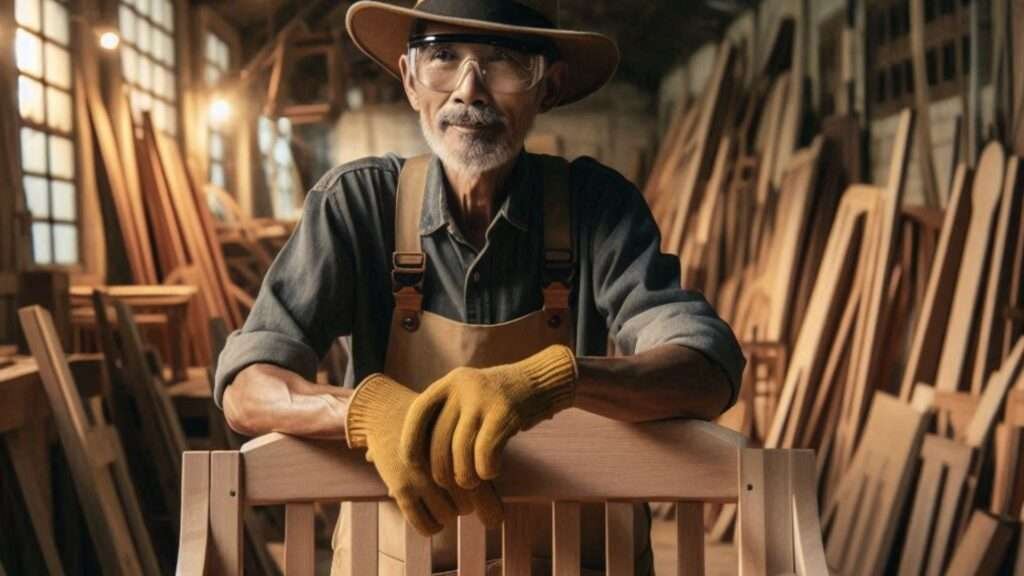We Learn And Improve From Our Woodwork Mistakes.

Woodworking, like any other skill intensive craft, is fraught with its unique set of challenges and complexities.
Whether you are an experienced artisan or a novice just starting out, encountering failures is an unavoidable aspect of the woodworking journey.
The intricate nature of working with wood, with its unpredictable grains and knots, means that even the most meticulous plans can sometimes go awry.
Recognizing this, it becomes evident that mistakes are not merely setbacks but are integral to the learning process.
Occasionally failing is inevitability with any form of woodworking and each time we fail is an opportunity to encourage a shift in perspective internally.
Instead of viewing these moments of frustration as discouragements, it is crucial to embrace them as valuable learning opportunities.
Each mistake holds a lesson that can enhance your skills, broaden your understanding of the craft, and ultimately contribute to the creation of masterpieces.
By accepting that errors are a natural part of the woodworking experience, woodworkers can cultivate resilience and creativity, transforming their approach to problem-solving and project execution.
As you delve further into the art of woodworking, it becomes clear that the journey is as important as the destination.
The moments of trial and error, the unexpected splits, and the misaligned joints all contribute to the richness of the experience.
There is no value in shying away from failures, instead we should embrace them, learn from them, and use them as stepping stones towards mastery.
By doing so, the woodworking community can foster a culture of continuous learning and improvement, turning every setback into an opportunity for growth.
The Importance Of A Growth Mindset With Woodworking.
A growth mindset is a crucial element in the journey of mastering woodworking. This concept emphasizes the belief that abilities and intelligence can be developed through dedication and hard work.
In the realm of woodworking, adopting a growth mindset allows one to view failures not as setbacks but as opportunities for learning and improvement.
If you undertake enough woodworking tasks, mistakes are inevitable.
Cuts may be misaligned, joints might not fit perfectly, or finishes could turn out uneven.
However, these errors are not signs of incompetence; rather, they are integral steps in the learning process.
By maintaining a positive attitude towards these failures, woodworkers can dissect their mistakes, understand the root causes, and refine their techniques for better results in future projects.
Renowned woodworkers often attribute their mastery to the lessons learned from their mistakes.
For instance, Sam Maloof, an iconic figure in woodworking, faced numerous challenges early in his career.
Instead of being discouraged by his initial failures, he embraced them, analyzing each error meticulously. This approach allowed Maloof to develop innovative techniques and designs that revolutionized furniture making.
Another example is Krenov, who frequently spoke about the importance of patience and perseverance.
He acknowledged that his early works were far from perfect, but by embracing a growth mindset, he continuously improved his skills.
Krenov’s ability to transform his mistakes into learning experiences contributed significantly to his legacy as a master craftsman.
Adopting a growth mindset in woodworking not only fosters personal development but also cultivates resilience and adaptability.
It encourages woodworkers to experiment, take risks, and push the boundaries of their creativity.
By viewing failures as stepping stones rather than obstacles, one can transform mistakes into masterpieces, ultimately achieving a higher level of craftsmanship.
Defining Success and Failure in Your Woodworking Projects.
In the realm of woodworking, the concepts of success and failure are often subjective and rooted in personal standards.
Establishing clear criteria for what you consider a successful project is crucial. This involves setting benchmarks for craftsmanship, precision, and overall aesthetic that align with your aspirations as a woodworker.
By defining these parameters, you create a roadmap that guides you through each stage of your project, ensuring that you remain focused on achieving a high-quality outcome.
Attention to detail is a hallmark of excellent woodworking. Being meticulous about quality allows you to spot potential issues early in the process.
This proactive approach not only helps in avoiding costly mistakes but also fosters a deeper understanding of your craft.
For instance, regularly assessing the alignment of joints, the smoothness of finishes, and the integrity of your materials can significantly enhance the final product.
This level of scrutiny empowers you to make necessary adjustments before minor imperfections evolve into major flaws.
Creating a checklist or a set of criteria for evaluating your work can be an invaluable tool in maintaining consistency and achieving your desired results.
This checklist might include elements such as the accuracy of measurements, the sturdiness of construction, and the quality of the finish.
By having a concrete list of standards, you can systematically review your project at various stages, ensuring that each component meets your defined criteria.
Moreover, setting personal standards and having a structured approach to evaluation not only boosts the quality of your woodworking projects but also enhances your skills over time.
As you refine your criteria and strive to meet them, you push yourself to become more adept and precise in your craft.
Ultimately, this continuous improvement cycle transforms mistakes into learning opportunities, paving the way for true mastery in woodworking.
Practical Tips With Learning from Woodwork Mistakes:
In the intricate art of woodworking, mistakes are inevitable, but they also present invaluable learning opportunities.
To transform these errors into educational experiences, it is crucial to adopt a methodical approach.
One of the most effective strategies is maintaining a woodworking journal. Documenting each project, including the mistakes made and the solutions applied, allows for reflection and continuous improvement.
The journal serves as a personalized reference guide, helping to avoid repeating past errors and fostering a deeper understanding of woodworking techniques.
Another vital tip is to actively seek feedback from seasoned woodworkers. Engaging with more experienced craftsmen can provide new perspectives and insights that might not be apparent to novices.
This can be done through local woodworking clubs or online communities where advice and critiques are readily shared.
Constructive feedback can pinpoint specific areas needing improvement and offer alternative methods for achieving desired results.
Additionally, leveraging online resources such as forums and woodworking classes can significantly enhance learning.
Forums are excellent platforms for posing questions, sharing experiences, and discovering new techniques.
They create a communal learning environment where one can benefit from the collective knowledge of the woodworking community.
Moreover, enrolling in woodworking classes, whether online or in person, can provide structured learning and hands-on experience under the guidance of professionals.
Ultimately, the key to learning from mistakes in woodworking lies in a proactive and open-minded approach.
By documenting errors, seeking expert feedback, and utilizing educational resources, woodworkers can turn their missteps into stepping stones for mastering their craft.
Embracing mistakes not only improves technical skills but also builds resilience and creativity, leading to the creation of true masterpieces.
The Benefits of High Internal Woodworking Quality Standards.
Maintaining high internal quality standards in woodworking can significantly elevate craftsmanship and customer satisfaction.
By being meticulous and detail-oriented, woodworkers ensure that each piece they create meets or exceeds expectations.
This rigorous attention to detail not only enhances the aesthetic appeal and structural integrity of the work but also fosters a sense of pride and accomplishment in the artisan.
One of the key benefits of adhering to high-quality standards is the development of a strong reputation for reliability and excellence.
When woodworkers consistently produce high-quality products, they build a loyal customer base that trusts and values their craftsmanship.
Word-of-mouth referrals and positive reviews often follow, further solidifying the woodworker’s reputation in the market.
This, in turn, can lead to increased demand for their services and the ability to command higher prices for their work.
Moreover, being fussy about one’s work can lead to long-term benefits such as reduced rework and fewer customer complaints.
High internal standards ensure that potential issues are identified and addressed during the production process, rather than after the product has reached the customer.
This proactive approach not only saves time and resources but also enhances customer satisfaction, as clients receive products that meet their expectations from the outset.
Woodworkers who maintain high standards often experience substantial personal and professional growth.
The pursuit of excellence pushes them to continually refine their skills and stay updated with the latest techniques and tools in the industry.
This commitment to ongoing improvement can lead to innovative designs and superior craftsmanship, setting them apart from competitors.
Ultimately, the meticulous approach to woodworking, characterized by high internal quality standards, can transform mistakes into valuable learning opportunities.
By striving for perfection and addressing errors with diligence, woodworkers can create masterpieces that stand the test of time, earning them a distinguished place in the world of craftsmanship.
Woodwork Business Customer Expectations and Feedback.
In the realm of woodworking, managing customer expectations is a critical component of ensuring project success and client satisfaction.
Clear and consistent communication with clients about the scope, timeline, and potential limitations of a project is essential.
Setting realistic expectations from the outset helps to prevent misunderstandings and fosters a transparent relationship between the woodworker and the client.
One effective strategy for managing customer expectations is to provide detailed project proposals.
These should outline every aspect of the project, including design specifications, material choices, estimated completion times, and costs.
By offering a comprehensive overview, clients are better informed about what to anticipate, which can mitigate potential disappointments.
Another vital aspect is regular updates throughout the project’s progression. Keeping clients informed about the status of their project, any challenges encountered, and how those challenges are being addressed can build trust and demonstrate professionalism.
This ongoing dialogue helps to manage expectations dynamically and ensures that clients are always in the loop.
Handling customer feedback, especially negative feedback, with grace and professionalism is equally important.
When a client expresses dissatisfaction, it is crucial to listen actively and empathetically.
Acknowledging their concerns without becoming defensive shows respect and a willingness to address their issues.
This can often turn a potentially negative situation into a positive one, reinforcing the customer’s confidence in the woodworker’s commitment to quality and service.
Using customer feedback as a learning opportunity can lead to significant improvements in both craftsmanship and customer service.
Analyzing the feedback to identify any recurring issues or areas for enhancement can help refine processes and techniques. In this way, feedback isn’t just a critique but a valuable tool for continuous improvement.
Ultimately, the goal is to cultivate a reputation for reliability and excellence in woodworking.
By managing expectations proactively and responding to feedback constructively, woodworkers can transform potential failures into opportunities for growth and success, ensuring that every project, even those that encounter challenges, can lead to a masterpiece.
Dealing With Woodworking Mistakes Can Be A Challenge.
Many of us believe that our passion for woodworking is unbreakable, but isn’t that just because we’ve never really put it to the test?
However, there are many hardworking people who can attest to the fact that their love for woodworking was severely tested and fractured after investing a significant amount of time, effort, and money in a failed woodworking project.
Failure can be frustrating when you know it wasn’t due to a lack of effort on your part. It can happen to anyone, whether they are novices, weekend warriors, or seasoned woodworkers.
The good news is that you are most likely only a few steps away from reaching your full potential and producing the amazing, high-quality results you want and deserve from your woodworking efforts.
Having to redo a failed project from scratch, whether it was a quoted or make-to-order job, is costly in two ways:
(1) You’re likely to lose money on that particular job
(2) The time you spend re-doing that failed job could have been better spent turning over a couple of small high profit items.
When things don’t go as planned, it’s always a good idea to figure out what’s causing the problem and how likely it is that it will happen again.
Then, with this information in mind, revisit the way you approach each project.
Proper Preparation Is Key. This involves cleaning up from the last job, re-organising the woodshop and sort out what you need for the next one.
Give your dust extraction systems service, ensure shop lighting is all good, make sure you have all of the materials and consumables you need for the next job and then do machine checks, tool maintenance & sharpening.
Using dull blades and bits can cause a variety of problems. For example, saw blades accumulate pitch and gum from the resins in the woods you cut over time.
This is especially true if you use a lot of softer woods, which contain a lot of moisture and resin. This build-up reduces the lifespan of your blade, reduces cut consistency, and may result in burning.
Worn router bits are more likely to chip wood than to cleanly remove it.
Wood will eventually be burned by carbide saw blades that have lost their edge, increasing the amount of sanding required. Send your blades to be sharpened on a regular basis, and consider purchasing a high-quality diamond sharpening system for bits.
Even though many woodworking projects are small and simple, you should plan any project that you expect to take more than a few hours to complete.
Which means you really need ‘flesh out’ the larger projects, including all dimensions, planned wood joints, what material cuts are necessary, and anything that will be attached to it.
The majority of woodworkers will create a fairly detailed drawing as well as a few sketches because larger projects can be laborious to plan.
Although we probably don’t like to admit it, few of us are able to draw a straight line, much less a circle, a square box, or a triangle.
Graph paper should be used all the time. Thanks to its perfectly aligned vertical and horizontal lines, we can easily draw an endless variety of geometric shapes by hand.
As yourself the questions, “How will I ensure quality and safety, What will I ensure that happens and What will I prevent from happening?”
Always adhere to the manufacturer’s safety instructions when using any tool or machine in your shop.
When performing any type of work, always wear safety glasses. Guards should never be tampered with and should always be left in place.
When using stationary jointers, table saws, bandsaws, routers, or other power saws, always use a push block, push shoe, or push stick.
A push stick’s primary function is to assist the user in moving a work-piece safely while keeping it flat against a machine table or fence while it is being cut.
Before placing power tools on the bench, ensure that they have completely stopped. Maintain your dust extraction equipment and wear respirators to protect your lungs.
Never Rush The Woodwork Finishing Process.
The last thing anyone should ever do after working on a quality project is rush the finishing process.
Improper sanding will leave blemishes in the finish; take your time and sand down to a high grit and then be sure to inspect all surfaces.
If you plan to use stains, always test them first on a sanded sample piece, especially dark tones. Spend some time researching the best finish for a specific wood and its intended use.
Extend your research to how to perform a specific finish to the highest standard. Wood finishing is an art that requires practise, patience, and planning.
Then ask yourself these questions:
(1) How will I manage your time?
(2) How much contingency should I allow for?
(3) How will I minimise distractions?
(4) How will I measure my overall progress?
When you’re struggling to finish a task in the allotted time, how can you tell if you’re being productive?
You won’t get better at anything by juggling a bunch tasks at once. Having too many balls in the air will keep you from fully committing to your core task and making the right amount of progress.
To be productive, you must complete your primary task, whatever it may be, and you must not allow anything to distract you from doing so. Being productive entails carrying out actions that result in the desired outcome.
Then comes the most important questions:
(1) How can I do better next time?
(2) Were there any opportunities for improvement?
(3) If I had to do 10 of those same jobs, how would I make it easier for myself?
When you have the time, try to broaden your skill set; sticking to one style of woodworking may be a mistake, and you may be leaving money on the table. For example, could learning about a few different types of carving add value to some of your projects?
Be Sure To Analyse Each And Every Woodworking Failure.
If when you review the project that went badly, you discover that the underlying cause was directly related to using a ‘less than ideal’ tool for a part of the job, you can naturally avoid re-occurrence by just buying the right one now.
But, why didn’t you pick up this problem during your preparation?
Are there other tools that you’ve been persevering with lately that are not necessarily the right tools for the task?
Don’t wait for the next problem to happen, spend the money and get your hands on the right tools for the job now.
The cost of the tool does not determine which one is the best for the task.
The tools that have the features you’ll need for both your current and future projects are the best for your woodworking endeavours.
For instance, because the size and nature of your projects will vary, think about investing capacity and ability when it comes to things like saws.
Many woodworkers begin with an inexpensive saw only to discover that the cut capacity wasn’t quite what they required.
Although they are more expensive, bulkier, and heavier than a table saw, investing in a contractor saw now means you will almost certainly never need to replace it.
However, if you stick with the table saw, you will eventually find yourself unable to handle larger jobs when they arise, and this problem may occur at the worst possible time.
There Is Always The Next Time.
As a woodworker, remember that mistakes are not just inevitable, they’re invaluable. Each error is a lesson in disguise, offering insights that textbooks and tutorials can’t provide.
Rather than letting setbacks discourage you, view them as stepping stones to improvement.
When a project doesn’t turn out as planned, take a few minutes to reflect and analyze what went wrong.
Was it a measurement miscalculation? A tool mishandled? This reflection is the first step towards refining your craft.
Remember, even master craftsmen were beginners once. They reached their level of expertise not by avoiding mistakes, but by learning from them.
So, pick up your tools with confidence, knowing that each “failure” brings you closer to success.
In woodworking, as in life, it’s not about never making mistakes, it’s about how you respond to them.
Embrace the learning process, and watch your skills flourish with each woodworking project.








[…] https://www.glzwoodw.biz/learning-from-our-mistakes/ […]
[…] LEARN FROM YOUR WOODWORKING MISTAKES […]